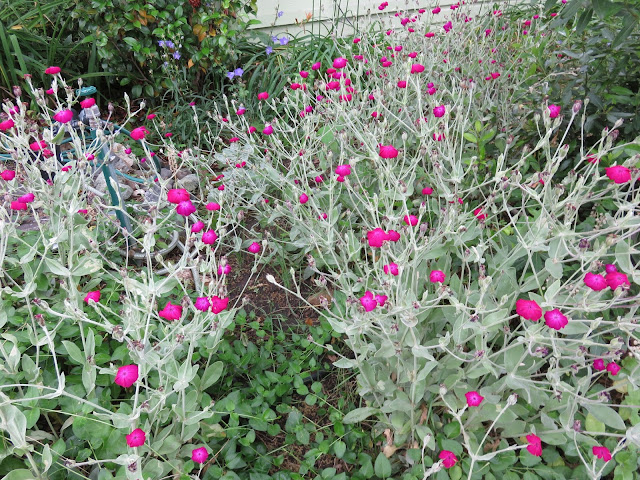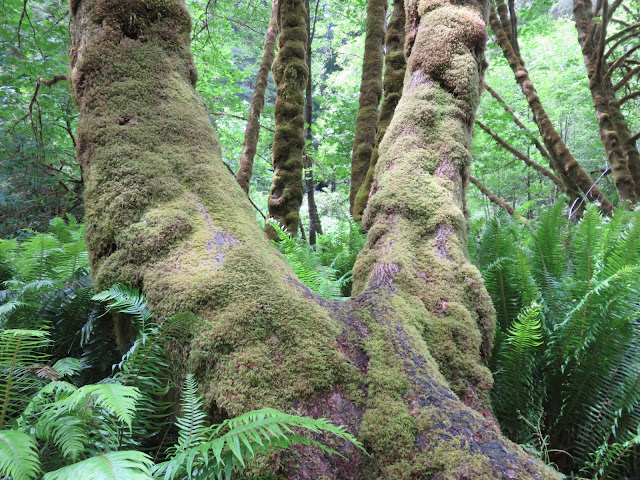From our RV Park, we were practically
walking distance to the Rogue, and nearly everywhere we turned, we saw the
river crashing through gorges, spilling over rocks, tumbling out of lava tubes,
and swirling in ancient black rock lava beds, all surrounded by lush and beautiful
trees, ferns, flowers, and moss. Hiking trails winding throughout the area allowed
us to see and experience the river in even more detail. As often happens, our
short visit here gave us just a taste of what the area is all about, and has
been added to our list of places to come back to for an extended visit sometime
in the future.
In 2007 Dan and I retired from work, hitched our 5th wheel to our truck, and hit the road. We are full time RV'ers so we take our home with us everywhere we go. We live by the credo "Home Is Where You Park It" and we have found Home in many an awesome setting! I created this blog to track our adventures as we travel around the US, Canada, and Mexico. Two of our goals include visiting all the State Capitals and as many of the Baseball Parks as possible, with everything else we can fit in between!
Monday, June 27, 2016
The Wild and Scenic Rogue River
Western Oregon is one of my
favorite places on this planet. I cannot get enough of the lush greenery, raging
rivers, abundant waterfalls, and hiking trails that wind through magical
ancient forests. When we selected Prospect, Oregon, as the place we would stay
for our Crater Lake visit, I had no idea we would be in the midst of such
majestic beauty. Prospect is located on the Rogue River, known for its salmon
runs, whitewater rafting, and rugged scenery and is one of the original eight
rivers named in the Wild and Scenic Rivers Act of 1968. Beginning near Crater Lake, the river flows
about 215 miles in a generally westward direction from the Cascade Mountain Range
to the Pacific Ocean.
Sunday, June 26, 2016
Crater Lake National Park
One of the rewards of living
life on the road is finding ourselves in proximity to this country’s glorious
National Parks. Sometimes they just happen to be “on the way” to somewhere we
are headed; other times we only have to tweak our route just slightly to build
in a visit. Such was the case with Crater Lake National Park. While it wasn’t
on the most direct route to our eventual stopping place in Maine (come July),
it was close enough to where we were staying in Redcrest, California that it
was a short one day drive in more or less the right direction. We had planned a
two night stay in Prospect Oregon, forty miles southwest of Crater Lake, then
decided to extend it by one more day in order to take in more of the
surrounding area.
Crater Lake was formed by a
massive volcanic eruption 7700 years ago which left a deep basin in the place
where a mountain peak once stood. Centuries of rain and snow filled the basin,
forming a deep blue lake whose waters are of unmatched color and clarity. It is
the deepest lake in the United States, measuring 1943 feet at the deepest
point, and holds 4.9 trillion gallons of water. The great depths of this lake,
and the fact that there are no streams or rivers feeding it, combine to create
the deep beautiful blue color Crater Lake is so famous for.
As luck would have it, our
visit coincided with a not so unusual mid-June snowstorm. It is typical for
June weather here to alternate between sunny warm days, rain, and snow. (The
week before and the week after we were there, were warm and sunny). Timing is
everything…still, we were able to visit the park briefly before it started
snowing and the lake became obscured by clouds. We will try to schedule a
return visit later in the summer next time!
Tuesday, June 14, 2016
Redwood National Park
Of all the times we’ve come to Northern California, and stayed in Weott and Redcrest (which are in the heart of redwood country), this is the first time we actually made the trip further north to visit the Redwood National Park. We opted to visit the portion of the park that’s in the town of Orick, about 80-miles north of where we were staying, and home to one of three Visitors Centers in the park. We picked up a map and a couple of brochures and covered as much ground as possible over about five hours.
Stepping into the forest is
like stepping back in time with old-growth trees that are centuries old, some
even over 1000 years old. 133,000 acres of state and national parks comprised
of temperate rain forests along the coast of Northern California all reside
within Del Norte and Humboldt Counties. These parks protect 45% of all the
remaining coast redwood old-growth forests, home to the tallest and one of the
most massive tree species on Earth.
It is hard to fathom that
nearly 90% of the original old-growth forest was destroyed after many decades
of unrestricted clear-cut logging (in 1850 redwood forest covered more than
2,000,000 acres of the California coast). I can’t understand how anyone could
be in the presence of such majesty and have any desire other than to preserve
and protect. Thanks to the serious efforts towards conservation began in the
1920’s by the Save-The-Redwoods League, and the eventual establishment of the
National Park in 1968, we are able to bear witness to these gentle giants in
what’s left of their natural environment. Here are some pictures from our much
too short visit.
Labels:
California,
June 2016,
National Parks,
Redwood National Park
Subscribe to:
Posts (Atom)



























































